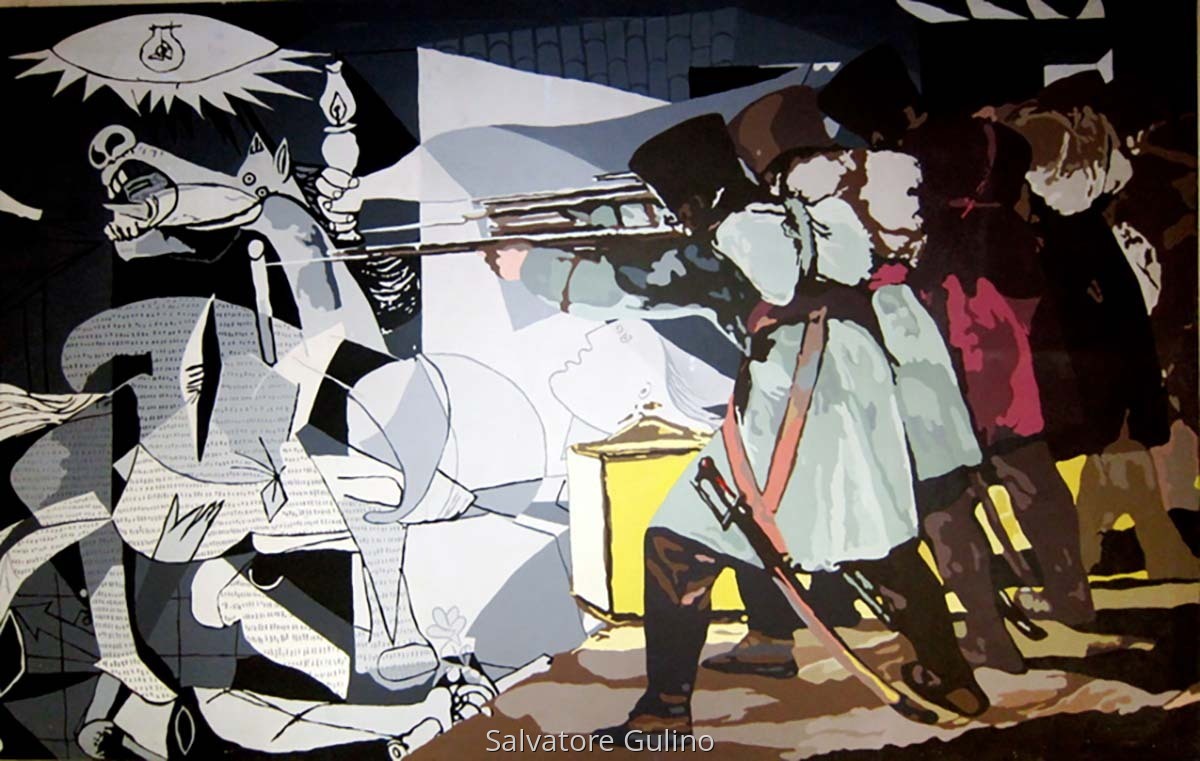
Kent State, May 4, 1970 (after Goya and Picasso)
Pairing:
Guernica by Pablo Picasso
The Third of May by Francisco Goya
Acrylic on canvas
Dimensions: 48" x 75"
Artist's Insights:
Q. The title of this painting is a bit mysterious. Those viewing it at the time it was painted, or shortly thereafter, could recall the date of the massacre at Kent State not to be confused with the Goya painting entitled The Third of May. How do you relate the contemporary event with the pairings you have chosen?
A. It came about because of how deeply I was affected by the Kent State incident in which many students were injured and some killed while they were protesting the Vietnam War. As soon as I heard the news, I went into my studio. In a few hours, I had the concept. I would use both Picasso's "Guernica" and Goya's "Third of May" and I would fuse them together.
Picasso's painting depicts in an excruciating manner the bombing of the small Spanish town of Guernica by German bombers allied with Spain's General Franco. Among the figures depicted was a woman falling out of a window, others clutching babies lying limp in their arms, crying out in pain, and wounded men lying on the ground, with severed arms and skeletal, bony hands still grasping their broken weapons. Also prominant in the painting was a dying horse on one knee. The Goya painting had always haunted me as well. The soldiers were faceless and therefore anonymous, only following orders, as it is often said. But the victims were real, especially the central figure with his arms outstretched. There can be little doubt that Goya and Picasso, two Spaniards, shared similar outrages at two different, yet similar, incidents in history. And history was repeating itself again.
After my painting was completed, I realized that it was different than the work I had done previously. It had a message. The message was political and it was quite clear. My earlier juxtapositions were in the pop art mode, no story, no emotion. I decided to go back to that approach which I have done.
There are many design elements involved in the juxtaposition. For example, the end of one of the bayonets reaches the horse and stabs it in the heart. The placement of Goya'a lantern and Picasso's head of a woman in the center of the action are exactly where they needed to be. But I actually don't remember pondering about their placement. It was a reflex action because I was so driven by the emotion of the moment.
As far as the ambiguity about the title, May 4, 1970 (after Picasso and Goya) is concerned, it is a coincidence that the massacre Goya depicted occurred on May 3, 1808.
Guernica by Pablo Picasso
The Third of May by Francisco Goya
Acrylic on canvas
Dimensions: 48" x 75"
Artist's Insights:
Q. The title of this painting is a bit mysterious. Those viewing it at the time it was painted, or shortly thereafter, could recall the date of the massacre at Kent State not to be confused with the Goya painting entitled The Third of May. How do you relate the contemporary event with the pairings you have chosen?
A. It came about because of how deeply I was affected by the Kent State incident in which many students were injured and some killed while they were protesting the Vietnam War. As soon as I heard the news, I went into my studio. In a few hours, I had the concept. I would use both Picasso's "Guernica" and Goya's "Third of May" and I would fuse them together.
Picasso's painting depicts in an excruciating manner the bombing of the small Spanish town of Guernica by German bombers allied with Spain's General Franco. Among the figures depicted was a woman falling out of a window, others clutching babies lying limp in their arms, crying out in pain, and wounded men lying on the ground, with severed arms and skeletal, bony hands still grasping their broken weapons. Also prominant in the painting was a dying horse on one knee. The Goya painting had always haunted me as well. The soldiers were faceless and therefore anonymous, only following orders, as it is often said. But the victims were real, especially the central figure with his arms outstretched. There can be little doubt that Goya and Picasso, two Spaniards, shared similar outrages at two different, yet similar, incidents in history. And history was repeating itself again.
After my painting was completed, I realized that it was different than the work I had done previously. It had a message. The message was political and it was quite clear. My earlier juxtapositions were in the pop art mode, no story, no emotion. I decided to go back to that approach which I have done.
There are many design elements involved in the juxtaposition. For example, the end of one of the bayonets reaches the horse and stabs it in the heart. The placement of Goya'a lantern and Picasso's head of a woman in the center of the action are exactly where they needed to be. But I actually don't remember pondering about their placement. It was a reflex action because I was so driven by the emotion of the moment.
As far as the ambiguity about the title, May 4, 1970 (after Picasso and Goya) is concerned, it is a coincidence that the massacre Goya depicted occurred on May 3, 1808.